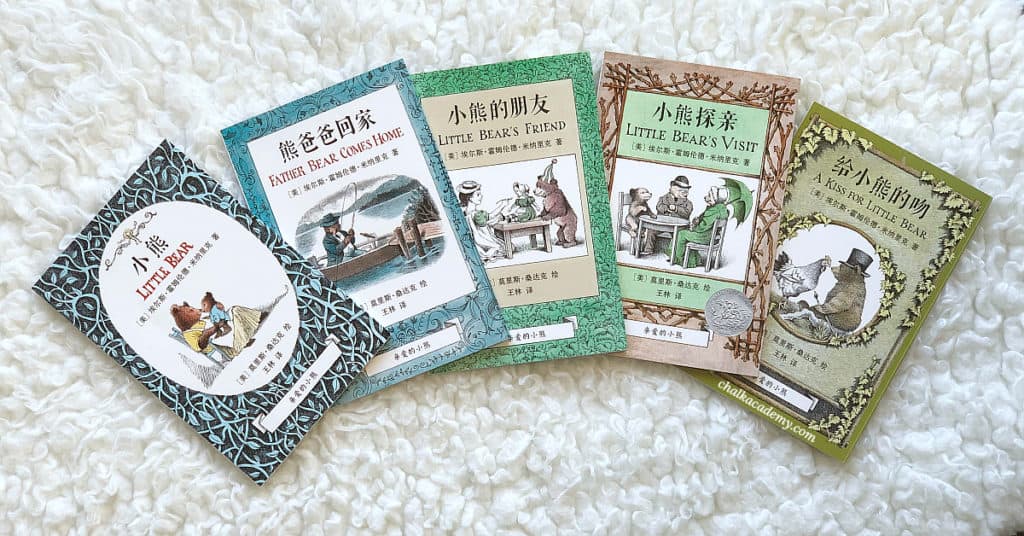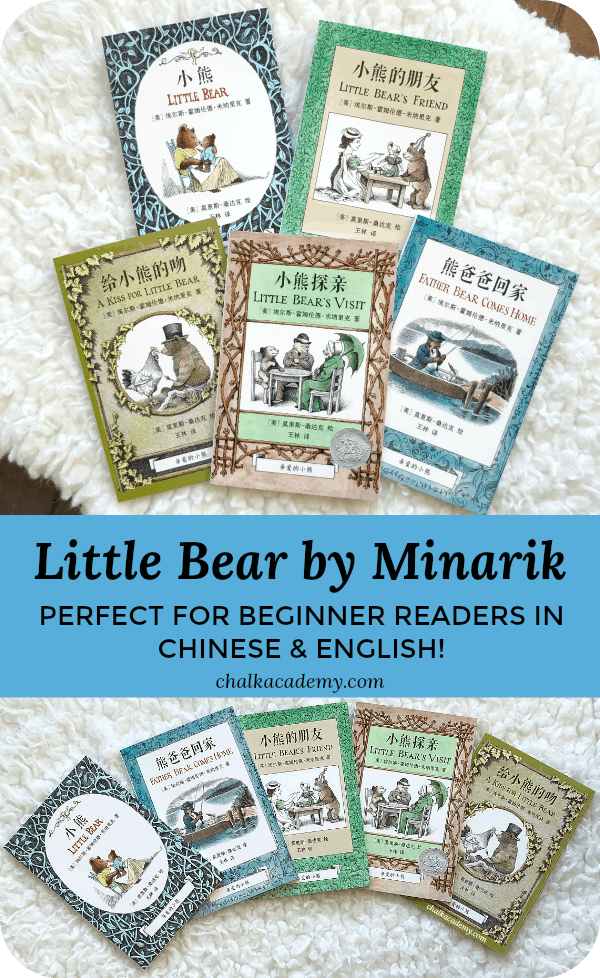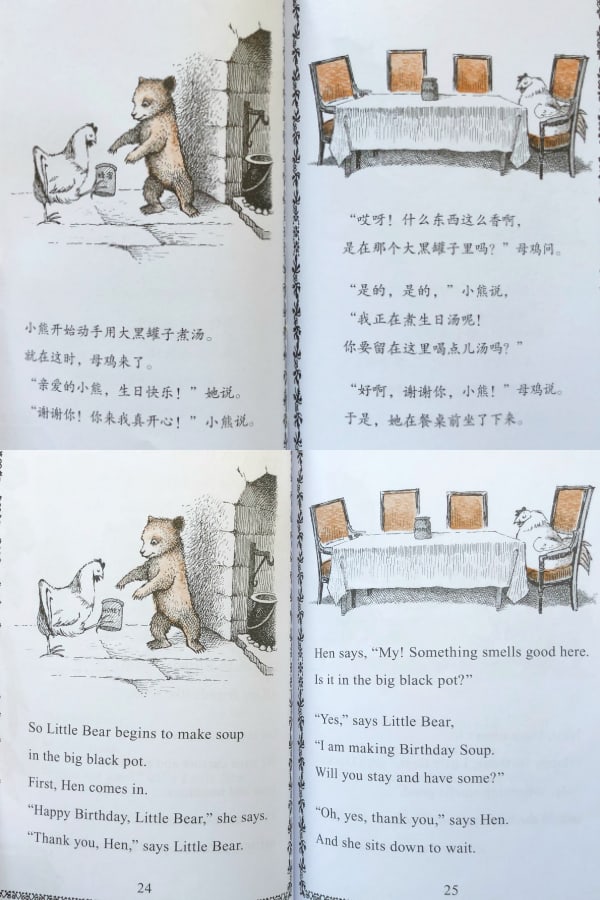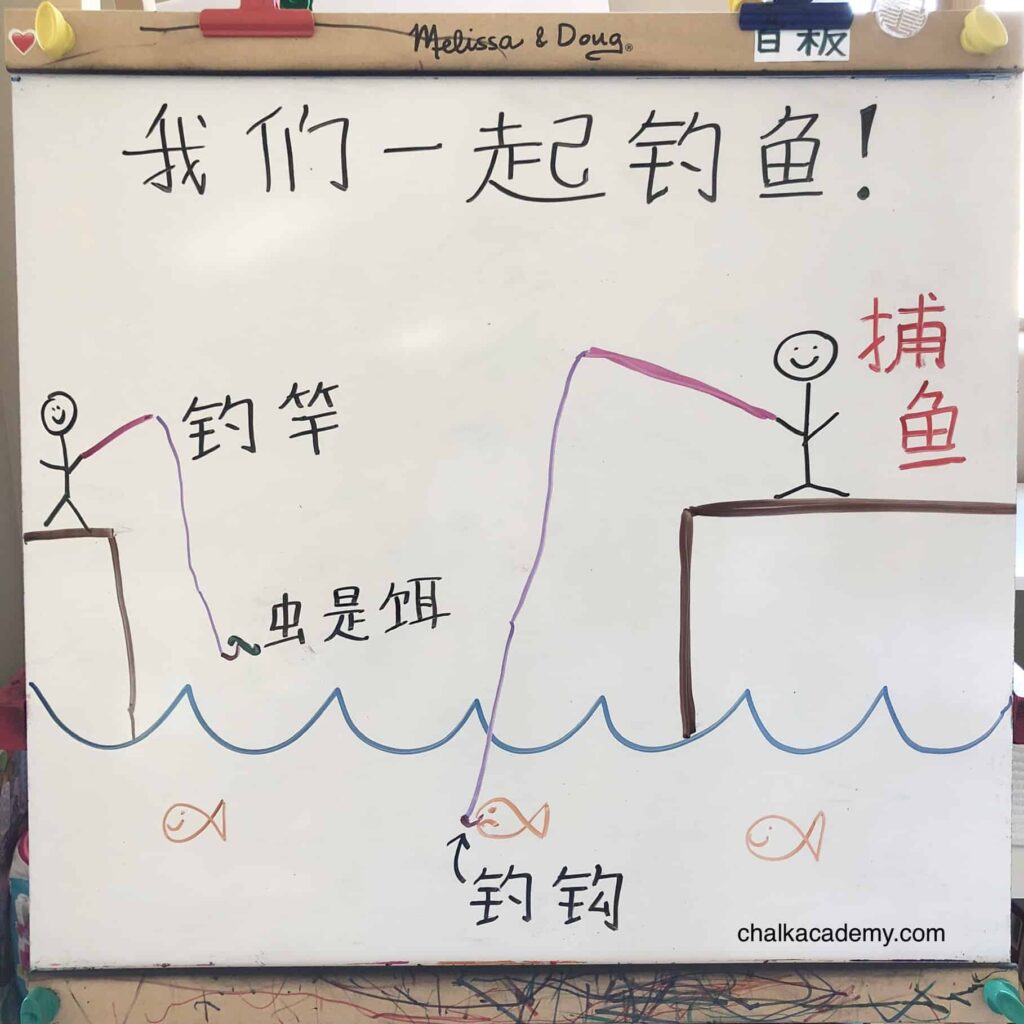Little Bear Books: Review of Bridge Books in Chinese & English

The Little Bear Books by Else Holmelund Minarik was one of the first set of “big kid” books that my daughter read in Chinese! We also have the series in English, but my daughter often doesn’t want to read the same books in another language. I recorded her reading one of these books in Chinese here, and it’s been so encouraging to see her progress when just a few years ago she was resistant to speaking Chinese. We’ve come a long way, and I want to spread the hope!
In any case, I think it is a wonderful series for beginner readers ready to reach the next milestone. Initially, I was listening to the audio narration for myself to learn Chinese, but my daughter was very intrigued. Since she asked to hear the stories over and over again, I realized I should buy the paperback set!

Chalk Academy is reader-supported. Some of the links are affiliate links. When you buy something through an affiliate link, we may earn a very small commission at no cost to you. Details here.
Little Bear Books《小熊》by Else Holmelund Minarik
- 作者 (Author): Elsa Holmelund Minarik and Maurice Sendak
- Where to buy:
- Simplified Chinese
- Traditional Chinese
- English
Little Bear Book Titles (Chinese and English)
- 小熊 Little Bear
- 给小熊的吻 A Kiss For Little Bear
- 熊爸爸回家 Father Bear Comes Home
- 熊的朋友 Little Bear’s Friend
- 熊探亲 Little Bear’s Visit
What are the Little Bear books about?
Little Bear《小熊》is an anthropomorphic series of stories centered around a bear, his parents, and animal friends (eg, chicken, cat, duck, owl). The old-fashioned stories have gentle humor and are adorable for young children.
Because the animals talk about wearing clothes, going fishing with dad, celebrating a birthday, imagination, and friendship, the series are great for building up common, everyday Chinese parenting and family vocabulary.
Since the series was originally written in English, the content is relatable for non-native learners such as our Chinese American family.
Why Little Bear books are an excellent bridge for budding readers
1. Repetition
In both English and Chinese, the story line has quite a bit of repetition which will help readers practice and memorize unfamiliar Chinese characters or English words throughout a chapter.
A few parents have told me that the stories are too repetitive and therefore mundane for their child, so please keep that in mind. We often don’t know which books will be a hit or drag until we try it!
2. Font size and spacing
Some pages have only a couple lines of text; others are filled with text. Also, the font is larger than most Chinese picture books with generous spacing between each line.
3. Supportive illustrations
However, there is still an ample amount of illustrations which are soft on the eyes and have lovely detail that supports the text.
Overall, the books seem to have positive reviews in both English and Chinese from other families. I would also consider the amount of animal-based stories that you have at home, as I think it’s important to have a balance of realistic, human-based stories that children can identify with.
Therefore, I recommend these English and Chinese bridge books to help kids gain confidence and reading stamina as they transition from simple picture books to chapter books.
Related: 青蛙和蟾蜍 Frog and Toad Books Chinese Bridge Books Review
A note about the English version of the Little Bear Books
The English books are categorized as I Can Read Series Beginner Level 1. Since we are mainly focusing on Chinese learning at home, we have not yet read the English versions of the Little Bear books.
However, I bought 3 of the Minarik books in English and noticed that the flow and layout of the books seem to be identical to the Chinese translation! The Little Bear’s Visit story has a Caldecott Medal that is printed flat on the cover of both language versions.
I think this will be a great set for my daughter to read in English in the future.
What’s inside the Little Bear Books?
Take a look at the photographs that I have shared below or consider borrowing a copy at your local library to see if your child might be interested in this set!
For comparison, I included photos of our 3 English Little Bear books.





Our experience with the Little Bear books《小熊》by Else Holmelund Minarik
Chinese bridge books after Sagebooks, Greenfield, and other leveled readers
After completing the Sagebooks and Greenfield reading curricula as well as learning through our hands-on activities, my daughter and I read explored these stories when she was age 3 years 10 months until she was about 4 years 3 months old.
We listened to all of the stories and read most of them on and off during this time period when she doing the 四五快读 curriculum.
In terms of reading difficulty, the books have no particular progression for difficulty level. Actually, 小熊 and 给小熊的吻 are the two easiest stories.
The 小熊 was easy for my daughter because it mainly discusses different types of clothing. Previously, my daughter learned to read clothing-related characters from our free bilingual printable clothing flashcards.
Getting used to long passages
When my daughter first started the Little Bear books, the full pages of text were intimidating.
During and after completing 四五快读, her reading stamina and confidence improved significantly, and she was more comfortable with the Little Bear series.
Reading schedule (or lack thereof)
Since my daughter was only 4, we just read and listened to whatever story that my daughter felt like. In contrast to Chinese leveled readers, we did not follow a strict order.
Recently, I have been taking these stories out again because my 2-year-old son likes animal stories. He really likes the illustrations and the repetitive nature of the writing, often echoing what I am saying. He only knows a few simple Chinese characters (eg, 小) and likes to point them out when he notices them!
Chinese character review with Little Bear Books
Here is a picture of something I drew on our Melissa and Doug easel to help my daughter remember new Chinese characters from a story about fishing!

Two thumbs up for Little Bear Books!
If your kids don’t mind animal stories with repetition, I recommend the Little Bear books for Chinese and English reading practice.
Each story introduces a wide range of relevant vocabulary. In addition, the animal relationships and illustrations are so sweet!
WHERE TO BUY CHINESE BOOKS FOR KIDS
For more Chinese book recommendations for kids, please visit and bookmark this link of our favorite books! Every week, I will be adding book reviews to this website!
If you’re wondering where to buy Chinese books for children, please click here for a list of the most popular online bookstores!

Hi Betty, I’m from Singapore and I just starting visiting your website couple of days ago. I can’t tell you how inspired I am by your journey!
My son just turned 5yo and I have already started him on Si Wu Kuai Du, our first leveled reader. I am a fluent Chinese reader myself but unfortunately, while my son has a reasonable comprehension of the language, he is more comfortable with speaking in English. Recently, however, he has started speaking Mandarin after my husband and I decided to speak Mandarin exclusively at home and I’m very encouraged! I plan to go through the Odonata series after this. During this period, I read 1 Chinese storybooks with more interesting plots to him at bedtime.
I’ve got a few questions which I’m hoping you could advise on (esp *3):
1) Assuming that he effectively masters the characters introduced in Si Wu Kuai Du, which level should I start from for Odonata?
2) Also assuming he effectively masters the characters from Si Wu Kuai Du, would he be ready to read bridged storybooks?
*3) In embarking on bridged storybooks, there would be words that have not previously been introduced in the level readers. How should I approach them? E.g. should I try to pre-identify and teach them to my son before reading the book? Or should I just casually read them for him while he reads those that are familiar to him. Then over time, consolidate some words to reinforce to him.
Thanks in advance for answering my questions and may your beautiful family continue to grow in this journey.
Hi Olivia! Thanks for sharing about your family and also sorry for just getting a chance to reply now!
1) I bought the full set of Odonata, this post about Odonata explains how we used it.
2) Yes! 四五快读 really helped my daughter get used to long pages of text. She easily transitioned to Chinese bridge books after this set!
3) When my daughter was reading bridge books, I was not able to read as well as her. So she would just read and then bookmark or ask me about unfamiliar words. Then I would write it large on a post it. Sometimes we would play a game like tic-tac-toe to help review it, but otherwise, she would get natural review of the word by finding it in other sentences and books. If you have time, you can pre-read and look for the words your child not know, but I don’t think it’s necessary.